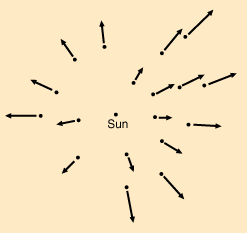
The further a galaxy is from us, the faster it is moving away. This is because the space inbetween the galaxies is expanding. This result is not particular to our region of space: the same phenomenon would be measured anywhere in the universe.
The clue came in the 1920's when astronomers discovered that all the other galaxies in the universe, in every direction, are moving away from us.[1] And crucially, the further away they are, the faster they are going.
There is nothing unique about our position in this regard; if you were anywhere else in the universe you would observe the same thing. All other galaxies would be moving away from you, and moving faster the further away they were. This is because the galaxies are not themselves moving through space, but rather the space itself is expanding between them.
A useful analogy is a loaf of raisin bread rising as it bakes. Like space, the dough expands as it rises. Like galaxies, the raisins grow further and further apart as the dough expands, and the distance they move apart is proportional to their initial separation.[2]
It is important to note the limits of this analogy. Unlike a loaf of bread, the universe has no edge[3], so there is no sense in which it is expanding into some bigger external space. As far as we can observe, the universe is all there is and at every point it is expanding.
All galaxies are moving away from us with the exception of a few of our closest neighbouring galaxies (our local "cluster"), for which the local gravitational attraction counteracts the expansion
The velocity of the galaxies away from us is measured from the red-shift of the light, similar to the Doppler effect for sound waves.
Note that the raisins themselves don't expand. Similarly galaxies stay the same size as they are bound by their own gravity.
The universe has no edge that we've been able to observe.
Before it was observed that the universe is expanding, other theories had been put forward that were consistent with general relativity, the theory which had established the relationship between the distribution of mass and energy and the shape of spacetime. Einstein had posited a static homogeneous distribution of matter throughout spacetime. In 1922 Friedmann showed that this setup was unstable, since the smallest disturbance would cause it to expand or contract.
We can gauge the distance of nearby galaxies using Cepheid variables. For galaxies further away, one method is to gauge its brightness, which indicates the distance using the Tully-Fisher Relation. It is possible a galaxy can be fainter because it is smaller, but because of gravitational lensing we can directly compare redshift of stars for which we know one is behind the other.
Another analogy for the expansion of the universe is to consider ants walking around on the two-dimensional surface of an inflating balloon. It seems to the ants as if points on the balloon are moving away from them, but it is really the surface of the balloon, analogous to space, which is expanding between them.
Again this analogy has limitations. From our perspective the balloon is expanding into three-dimensional space, but there is no such space for the universe to expand into. We just measure it intrinsically expanding and that's all we can say.
See balloon analogy in cosmology from Ned Wright's Cosmology Tutorial.
Author: Tom Brown
Copyright: public domain
Date last modified: 11th Oct 2011
Peer-review status: Not yet peer-reviewed
Universe expansion: source: http://hyperphysics.phy-astr.gsu.edu/hbase/astro/hubble.html, copyright: unknown
Hubble 1929 graph: source: http://www.astro.ucla.edu/~wright/cosmo_01.htm, copyright: unknown